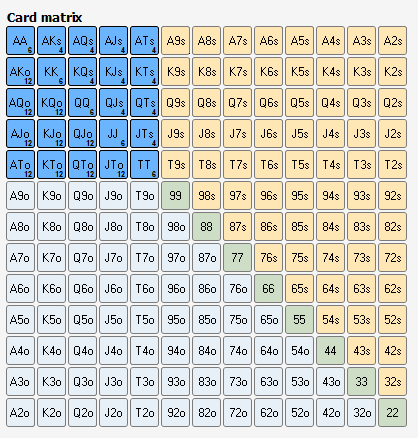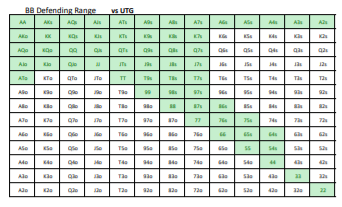In poker, hands you play pre-flop will have dramatic effects on your profitability.
It is important that you are only playing the best hands possible preflop. This makes it more likely you will beat
your opponents. It is vital that you include starting combos that become stronger as the hand develops. Hands such as
JT Suited can hit more straights and flushes compared to J8 off-suit.
Poker is dynamic, and you should pay attention to the changing factors at the table. These dictate whether you should play more hands or less hands and the type of hands you play. This is due to different stack-sizes, the stage of the poker tournament, down to your position on the table.

A good poker hand is one that is going to win more often against the hands your opponent could have. Because you will not know exactly what your opponent has, you want your hand to be better on average. Each starting hand will have a percentage chance to win the pot before all the other cards come out. You want to play the hands that give you the best chance to win. Generally, you should start by playing hands with good Raw Equity.
Raw Equity in poker is the percentage chance your hand will win if there were no other factors at play.
You also do not want to be predictable with the hands you could have in a situation. Good players play the hands that still have a good chance to win but can improve on a variety of board textures. Pros choose the best card combinations ones that are “Playable” post-flop.
Hands that we open in poker should not only have a good chance of winning, but also be playable. Some hands may have similar equity to each other. A hand such as T2 can only make vulnerable pairs, increasing the chance you get bluffed. While 67 (worse than T2 in more can flop extra outs to make hands such as straights or flushes. That makes 67s more playable than T2. A hand is payable if it has a good chance of realising its equity.
Equity realisation in poker: the amount a hand can expect to win based on its raw equity and other post-flop factors. These factors include bluffing, getting bluffed or not getting the required odds to call.
Hands that realize their equity when they connect with board textures well. This can be either: immediately hitting good top pairs or better. Or you have straight and flush outs making your hand likely to improve.
Hands such as suited connectors go up in value as they can make straights and flushes.
You are more likely to make a straight the closer the cards are connected. Hands that are in sequence i.e., 67 or 78 are more valuable than “one gappers” or worse, i.e., 79 or 35.
Suited combinations also go up in value, this is because if you flop a flush-draw, you pick up more equity. Having both a straight and flush-draw significantly increases your chance of winning a pot.
To bluff your opponent on any board, you need to be able to have strong hands in that situation. Your opponent knows that you never have the strongest holdings on low boards. If you are not playing with a wide variety of cards and the board is 568, they can bluff you with ease. Therefore, the range of hands you play must be able to cover several flop outcomes.
For an absolute beginner, the best hands for you are ones that contain two “broadway” cards. A broadway card in poker is any card from the Ten to the Ace.
These hands always have good raw equity, they are strong enough to win 64% of the time against two random cards.
As you can see, against a player playing any two cards, with our high card only approach we are likely most of the time.
This is because when we hit a pair, it is likely to be top pair with a good kicker. This is an area of the game that beginners
find easier to understand. It limits beginners’ mistakes.


Unfortunately, most players do not play random cards. All players have a choice which cards they play. Most opponents will fold the hands with bad equity preflop.
By only playing with the hands listed above, we become predictable and easy to exploit. This also limits the number of hands we play and will impact our long-term profitability. Choosing only the strongest hands is not the optimal strategy. The best and balanced strategies are visible in preflop poker range charts.
There are hands in poker that you should play, hands that you could play and hands that you should never play.
Often the best way to see this information, is to visualize it onto a “Range Chart”. This is a grid with all the possible hands in it. The hands that you should be playing are highlighted for you. This differentiates them from hands you should fold preflop.
The hands on these carts are often part of a balanced, GTO preflop strategy.
This helps you avoid mistakes and make the most profit in the long run.

A range chart looks like this. It shows us the hands that are best for us to play from the Big Blind (BB) when the player Under the Gun (UTG) has open raised.
Range charts like this one incorporate all the factors talked about and show what the best hands to play are based on:
Summary: